All you need to know about your products!

| 3DNews Vendor Reference English Resource - All you need to know about your products! |
||||||
 |
||||||
|
|
||||||
Abit BH7 (Intel 845PE) Motherboard ReviewAuthor:Date: 29/04/2003
Some motherboard manufacturers have recently presented quite interesting products built on the i845PE chipset. Of most interest is the unofficial support for the new 200(800QP) MHz bus processors. Only the lazy ones have not produced such motherboards: Abit BH7, Epox 4PEA800 and MSI with the long name "845PE MAX3 800 Edition". What's more, Albatron has come up with its PX845PEV-800 and Gigabyte with its 8PE800/Pro/Ultra series. But the latter hasn't told anything regarding support for the 800 MHz bus. There is nothing special in supporting new processors by the i845PE/GE chipsets. In fact it means that the memory operation speed will be determined by the 1:1 multiplier (i.e. synchronous operation with the system bus). As a result, a vast majority of i845PE-based boards will run successfully with new Pentium4 processors (by the way, we have recently tested 13 such boards). Moreover, I wouldn't be too much surprised if boards based on the i845E chipset will run the newest processors (e.g. Asus P4B533-E or Gigabyte 8IEXP).
Another factor that determined the emergence of such boards is that Intel postponed the release of the new chipsets (Canterwood and Springdale) to April-May. That means the mass production of boards based on the i865 and i875 chipsets is scheduled for the coming summer, the off season for the whole IT industry (all reasonable people are sunbathing on the beach in that period :). It's natural to renew the assortment before novelties come up and to earn some more for the 800 MHz bus "pseudo-support". In fact, there are more serious grounds for that: Springdale-based motherboards which are coming out this summer will have a preliminary price around $125 onwards (more often they mention the figure of $150 onwards). So the companies are striving to present new products in the much lower-end sector of the market. Today, we'll be looking at the first one in this line - the Abit BH7 motherboard. In its development, the main focus was given to the maximum boost in the processor's and memory's overclocking options. Besides, all measures were taken push the board's price down. As a result, its price is now under $100. But the price reduction implies the package bundle will be scarce with the minimum number of integrated controllers. Abit BH7 Specifications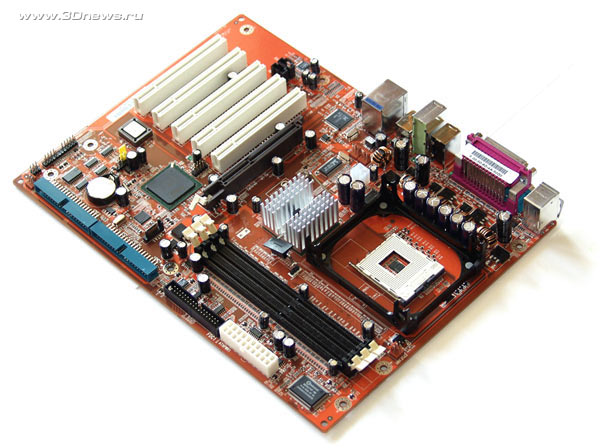
* - Unofficial support. Retail boxPackage bundle 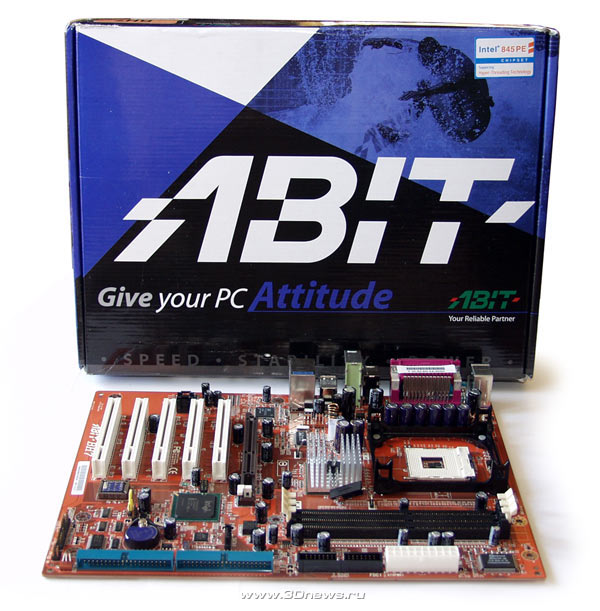
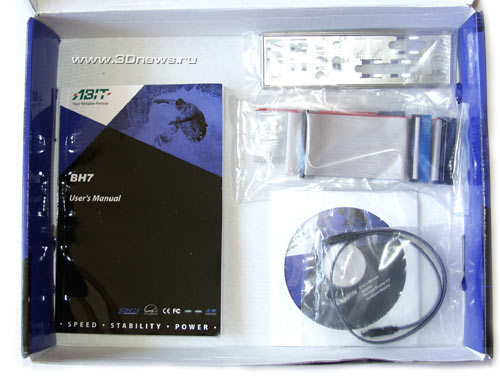
The board's package bundle is minimum: a user's guide, a drivers CD and a set of cables. Besides, there is one SerialATA cable, but support for this standard has already become an integral part in any motherboard. The quality of the user's manual is up to the mark: it gives a detailed description of all the jumpers and connectors; there is a section to do with BIOS settings and the procedure of driver installation. Much focus is given to the BIOS update. Of the software, there is only a system monitoring utility. In the upshot: the package bundle is worth the price of the motherboard. Abit BH7 FeaturesThis motherboard appears to be very compact (23 cm x 30 cm) and is made on orange PCB. 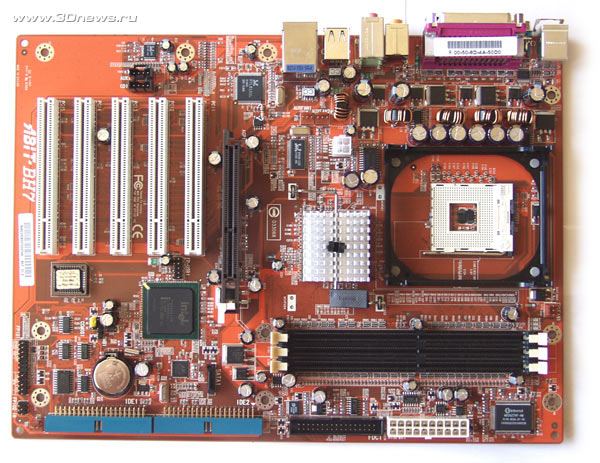
The board's design leaves a good impression: the main power socket is under the DIMM slots. That means the cables won't run loose inside the case and hinder the assembly. But the additional connector is positioned closer to the board's center, which is not the most important thing. There are four sockets for plugging in fans on the BH7 board: the CPUFAN1 is positioned near the socket and is meant for the processor cooler. 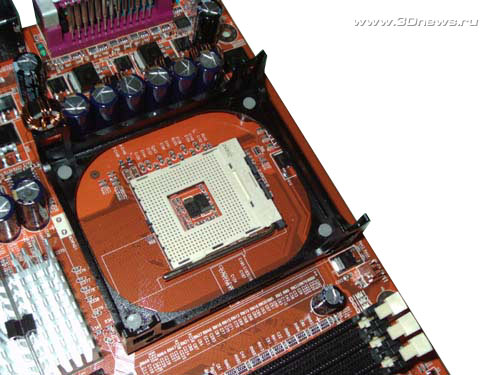
Two more connectors (AUXFAN1 and AUXFAN2) are positioned close to the North Bridge, with the last one (SYSFAN1) in the board's bottom left corner. Connecting and disconnecting fans is a breeze (I remember complaining much just about that when testing the IT7-MAX2 v2.0 board). To cool the chipset, a passive radiator is used. 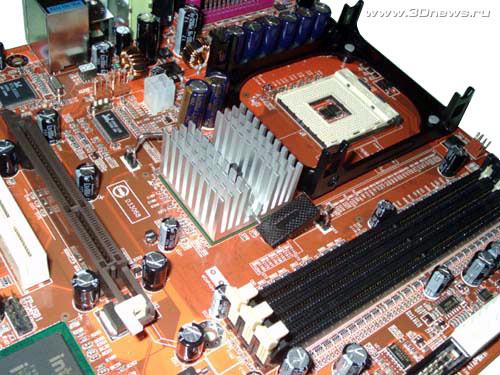
Below the North Bridge there are 3 DIMM slots, and the maximum memory capacity is 2 GB (restricted by the chipset). 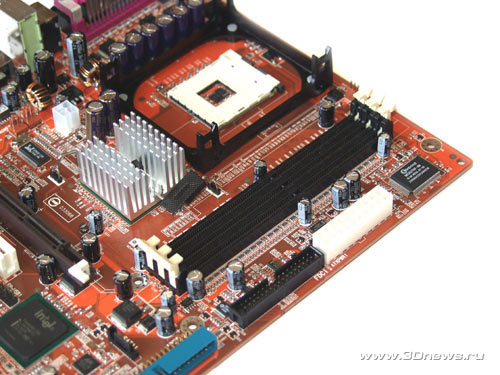
Once power is applied to the board, a yellow LED near main power socket lights up. When the board starts up, a red LED also lights up. It's nice to note that an AGP video card does not block the latches of the DIMM slots. As for the AGP slots, it supports only 1.5V AGP 4XX video cards (like all the other i845PE\GE-based motherboards). 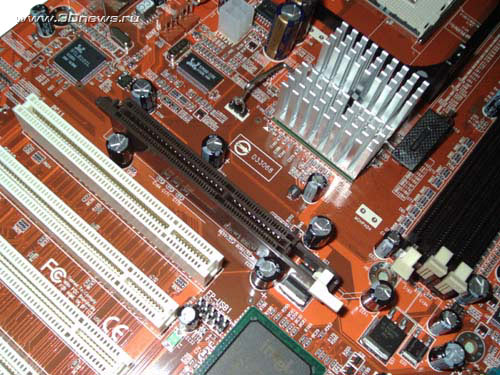
On the slot there is a special latch to keep the video card firmly in place. Besides the AGP slot there are 5 PCI slots on the Abit BH7 motherboard. 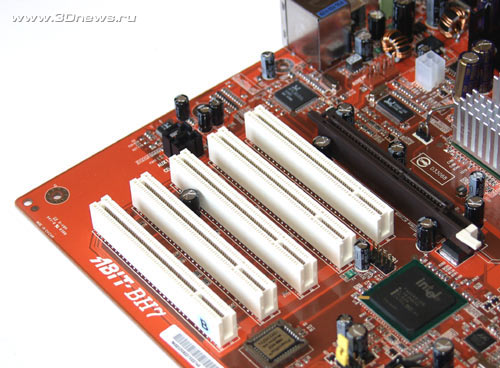
This number is quite enough for an entry-level system, especially if the board features 6-channel audio (ALC650) and an RTL8101 LAN controller. Of course, there is support for the USB2.0 - six ports, four of which located on the rear panel with the other two are plugged in via a header (missing in the bundle). The header is plugged in to the FP-USB1 connector located near the PCI1 and PCI2 slots. 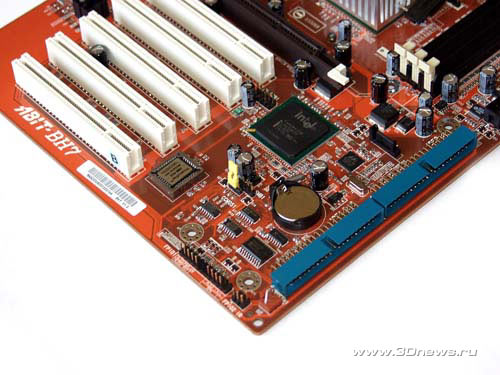
A couple of words on the disk subsystem. There is no integrated RAID controller on the BH7 board, but there is support for a SerialATA channel. To this end, there is a Marvell® 88i8030 controller on the board. Certainly, there is also support for the ParallelATA, as many as 4 devices can be plugged in to the integrated IDE controller. The respective connectors are painted in the same color (with explanatory captions as well) and are positioned in a pretty smart way - parallel to the board's plane. This technical trick is used to facilitate plugging in the cables; in so doing the pressure during installation is uniformly distributed over the board's area, which doesn't result in its bending. By the way, we have seen such orientation of the IDE connector in the Asus P4PE board. When plugging in a SerialATA device, you've got to keep in mind that the number of devices connected to the IDE2 channel is reduced (from two to one). Now take a look at the board's rear panel. 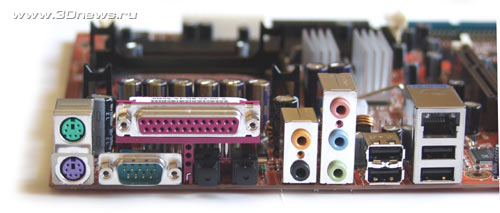
An absolutely nonstandard panel. Where the COM2 should be, there is an optical output, with four USB ports and a RJ45 port of the integrated LAN located further on. 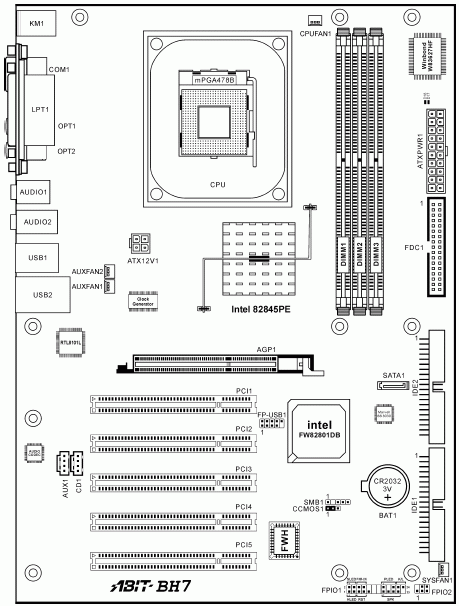
There is only one jumper on the Abit BH7 board - the CCMOS1 located near the battery cell and is meant for clearing the CMOS settings (or "BIOS reset"). The jumper has a plastic tail to make the switching easier; it's easy to find - the only yellow spot on the board :) (besides, there is a caption nearby). In fact, the quality of marking on the board is very good - all the captions are written in a large font, so they are easily seen inside the case. Now on to the BIOS settings. BIOSThe board's BIOS is based on Award Phoenix. 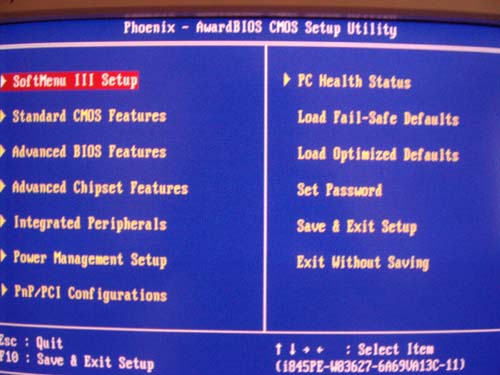
Let's move straight on to the section dealing with the RAM operating parameters. 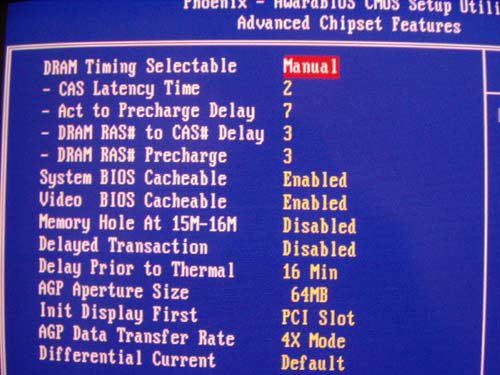
Here is a set of most important parameters: the "SDRAM Cas Latency" and "Precharge to Active"(Trp), "Active to precharge" (Tras) and "Active to CMD"(Trcd). Now look at the parameters responsible for selecting the memory clock speeds. For that, DRAM Ratio H/W Strap and DRAM Ratio are meant. 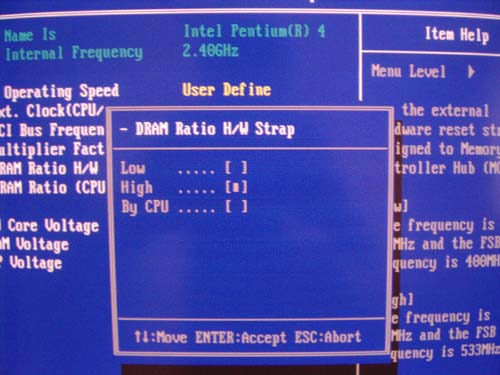
So, if you set the DRAM Ratio HW Strap to "Low", the chipset regards it as if a processor whose base FSB = 100(400)MHz is installed. Therefore, to enable support the DDR266 memory, the user can make use of the CPUMEM=3:4 divisor. In fact, you can use this divisor for processors featuring the FSB=133(533QP) MHz. As a result, the memory will run at 177 MHz(DDR354). As for the DRAM Ratio HW Strap="High", the CPU/MEM=4:5 divisor becomes accessible, which results in the memory frequency = 166 MHz(DDR333) for FSB=133 MHz. 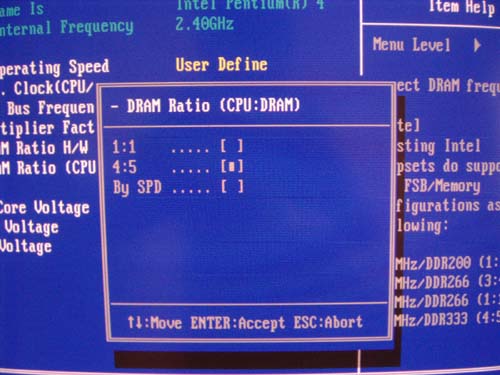
It turns out that with FSB set to 200 MHz the memory is able running at the following frequencies: 200MHz (DDR400 ; 1:1), 266MHz (DDR533 ; 4:3) and 250MHz (DDR500 ; 5:4). Clearly, there are no issues about the first - the DDR400 sells in every computer shop. But, as we know, the Pentium 4 system performance is in a strong dependence on the memory bandwidth. So it's most preferable that the memory run at a highest possible frequency. But it's not easy to acquire memory able running at 250 MHz (which equals DDR500). To date, only Geil is selling such modules that guarantee operation at such speeds. Otherwise, you have to choose modules and push up the memory voltage (fortunately, the BH7 offers powerful overclocking options). As for the DDR533, there is no such memory at all. A few notes on the system monitoring. 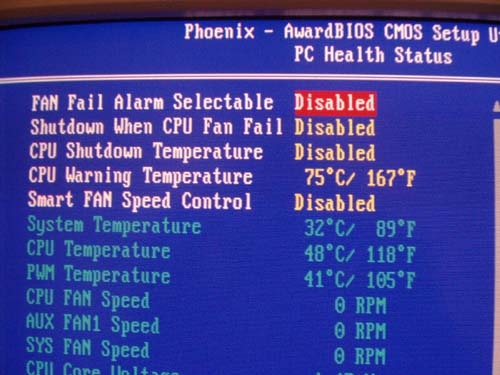 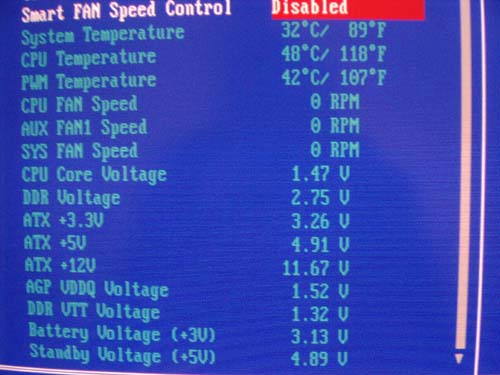
The board offers a wide selection of functions and sensors: monitored are the rotational speeds of the three fans, the processor and system temperatures, as well as all the voltages (including the battery voltage). There is a possibility to set two temperature limits for the processor. One temperature limit sets a value at which the alarm snaps on; upon exceeding the other limit the system powers off automatically. Besides, there are two interesting things: the "PWM Temperature" value is monitored on the screen. I can't tell precisely what sort of temperature is that - the user's manual has mention of this parameter at all (seems like I did it wrong praising the manual :). Most likely, it is the temperature of the board's power unit, since with a water cooling system on the temperature went up a bit higher than the processor temperature (tPWM > 63 deg C, tCPU <50 deg C). Once the tPWM temperature exceeded 75C, the system started suffering from overload. So owners of water cooling systems should consider getting additional fanning of the case. The Motherboard Monitor utility allows monitoring this parameter with the "Winbond 3" sensor. Another interesting thing is about the "Smart Fan Speed Control" function. 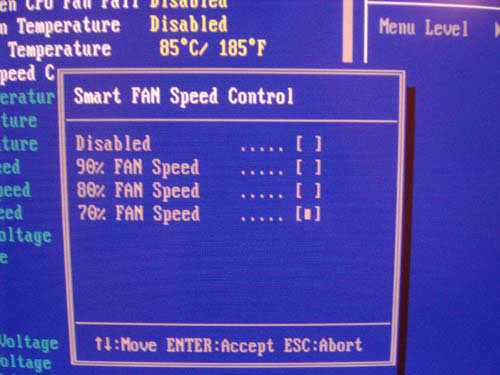
Depending on the processor load, it's possible to reduce the fan's rotational speed down to 70% of the original value. The fan has to be plugged in to the CPUFAN1 connector (we came across this claim when testing Asus motherboards (Asus Q-Fan)). Overclocking and stabilityDuring the tests, there was nothing to complain about stability of the board. The power converter is based on the 4-channel scheme and has eight 3300 mkF plus three 1200 mkF capacitors. 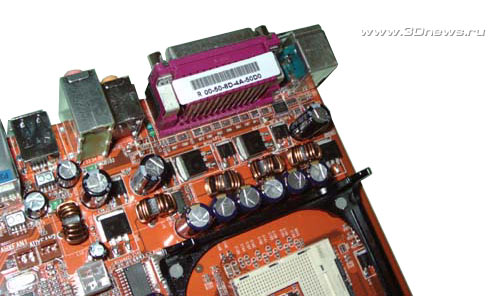
Now on to the overclocking options. To test the overclocking potentials, I used a Pentium4 2.4B processor, which as our stress test showed, provided a guaranteed running at FSB speeds up to 180 MHz inclusive. All the overclocking options are traditional for Abit motherboard and are gathered in the "SoftMenu III" section. 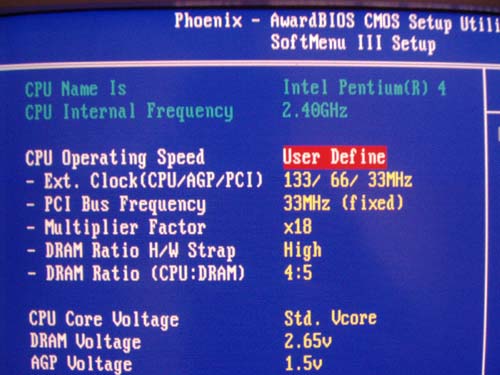
Look at the FSB variation range, which is as wide as 100 - 250 MHz (in 1 MHz increments). 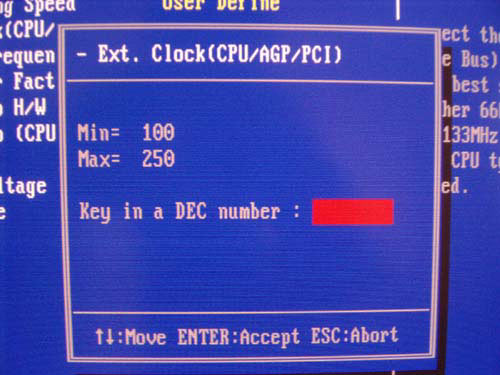
The second important item is varying the processor voltage. To attain stability, the overclocker can raise the Vcore by 30% of the nominal value. This is about too much: with the nominal Vcore = 1.5V the maximum boost equals 0.45V (i.e. the maximum Vcore = 1.95V), and the variation is performed in 0.075V (5%) increments. 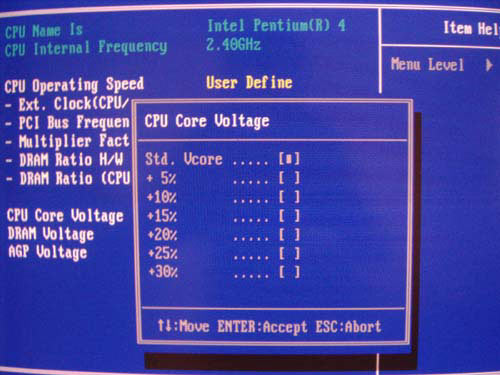
So overclockers have every reason to be pleased by the wide processor voltage variation range, but the increment at which the variation is done is too big (0.025V would have been much better). Next item is in charge of raising the memory voltage (Vmem). Its variation range is between nominal 2.55V and 3.05V (in 0.05V increments). 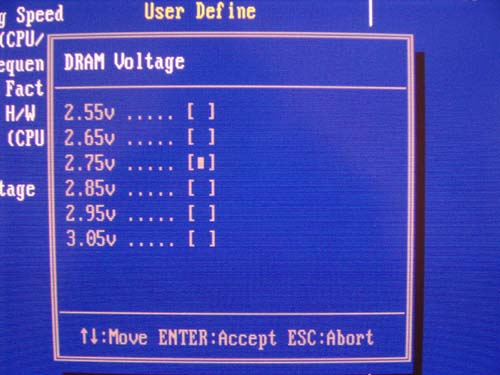
The range is superb - we've got a really fantastic tool for overclocking the memory. And finally it's possible raising the AGP voltage. The admissible values are: 1.5V (nominal voltage) and 1.6V. 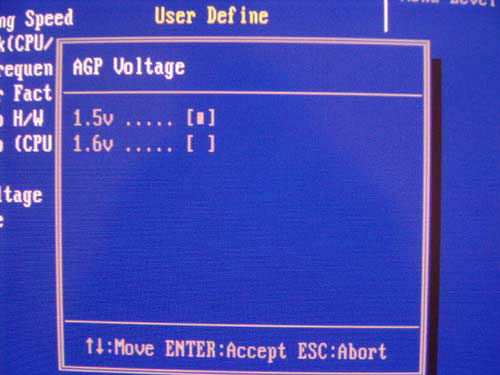
At increased speeds it is important that the PCI and AGP bus speeds not depart from the standard 33 and 66 MHz, respectively, if possible. This is primarily important for the correct hard disk functioning. The possibility to set a fixed PCI bus speed is there on most i845PE motherboards. But on the Abit BH7 motherboard this function is missing - the PCI speed is set in direct dependence on the FSB speed. The following divisors (PCI/FSB) are accessible: 1/3, 1/4, 1/5 and 1/6. 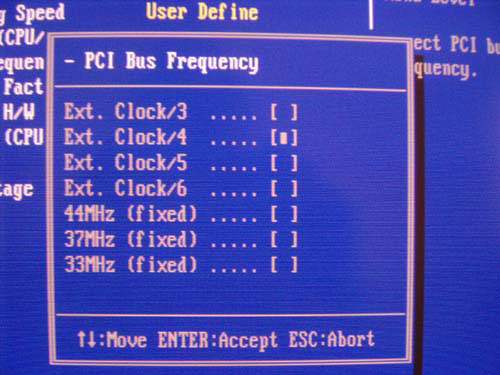
The maximum stable bus speed of our board in question amounted to 180 MHz with the air-cooling system used, and 185 MHz with water cooling. 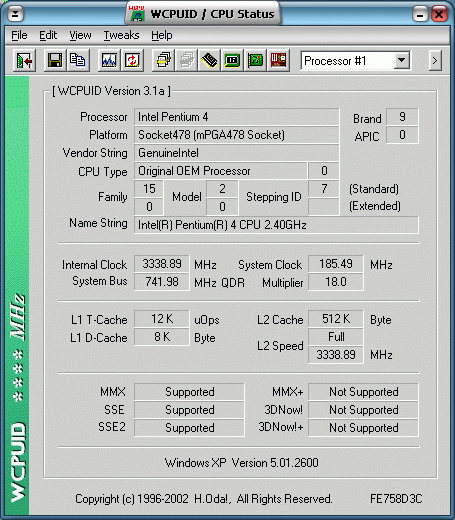
The general conclusion is this - the Abit BH7 has a most powerful among i845PEGE motherboards selection of options for overclocking the processor and memory. PerformanceAs a contender to our motherboard we used the Abit BE7 based on the i845PE chipset. In our testing system we used the following hardware:
Let's first take a look at the results of synthetic benchmarks. 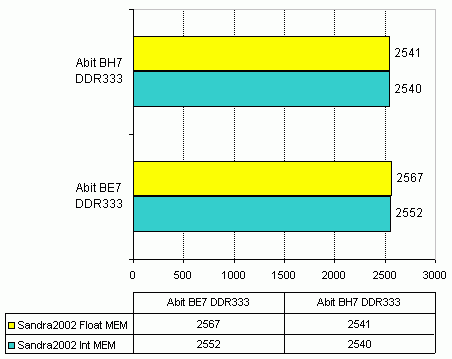
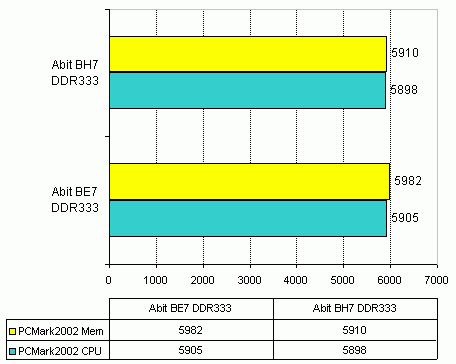
Now on to the gaming benchmarks. 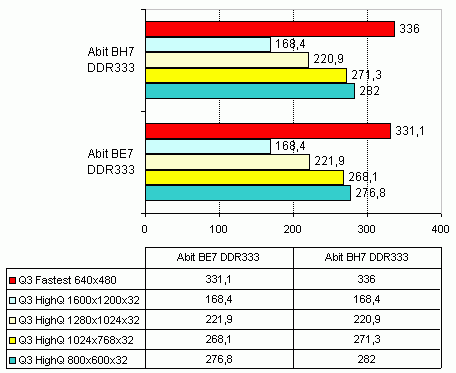
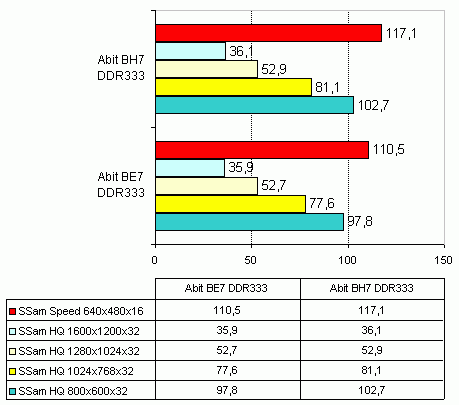
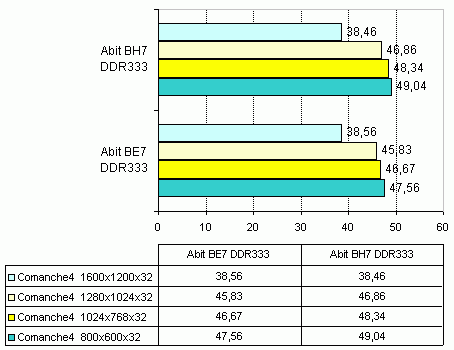
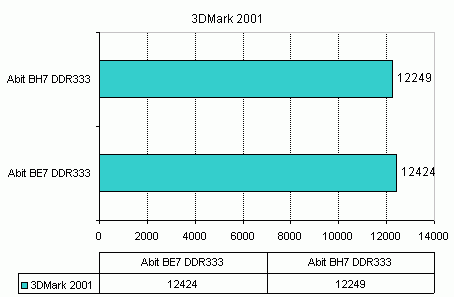
The board demonstrated good speed characteristics. In fact, performance is not the most critical factor in choosing the right motherboard. What matters more than that is price, reliability/stability and feature-set. FindingsDespite the modest look, the Abit BH7 offers very powerful overclocking options. Besides, the board features integrated 6-channel audio, a LAN controller and six USB 2.0 ports. What is more, the board offers one SerialATA channel. Another advantage of the board is its low price which is now under $100 (currently, $90 on the date it is being tested). ConclusionPros:
Read more on this topic
|
|||||||||||||||||||||||||||||||||||||||||||||||||||||||||||||
|
|||||